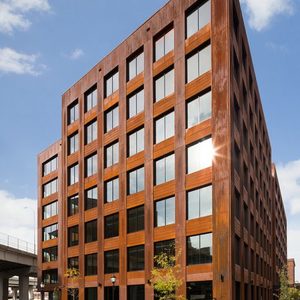Image Credit: Images #1 and #3: Michael Green Architecture / Lotus Equity Group
Image Credit: Images #1 and #3: Michael Green Architecture / Lotus Equity Group The Newark Bears Stadium, which has been mostly unused since the minor league baseball team folded four years ago, will be the site of a new mass-timber office building. (Image credit: WCK / Flickr)
Image Credit: Image #2: WCK / Flickr The building could be constructed with dowel-laminated panels, according to the developer. Unlike cross-laminated timber panels, they are not held together with glue.
Mass timber construction seems to be picking up steam. Developers have announced plans for an 11-story mass timber building in Newark, New Jersey, that would house 500,000 square feet of office space and be nearly twice as big as similar timber structures in Chicago and Minneapolis.
New York-based Lotus Equity Group says the office building will be constructed on a nearly 12-acre site and become part of a mixed-use development called Riverfront Park. The office tower, which would be the largest mass timber building in the U.S., will be built on the site of Newark Bears Stadium, home of a minor league baseball team that folded in 2014, according to a report published by NJ Advance Media.
The architect is Michael Green, who also designed mass timber buildings for Hines, a real estate developer, in Chicago and Minneapolis. The seven-story T3 Tower in Minneapolis, completed in 2016, was the country’s first modern timber tower (T3 stands for timber, technology and transit). At seven stories and 220,000 square feet, it was the largest in the U.S.
The following year, Hines announced plans to build an even bigger mass timber tower, T3 Goose Island in Chicago. It will be six stories tall and 270,000 square feet, slightly bigger than the Minneapolis tower, but only about half the size of the Newark project.
More than one type of mass timber
One option for the Riverfront Park building, according to the developer, is to use dowel-laminated panels. They are similar to cross-laminated timber (CLT) panels, except that they are assembled with dowels rather than glue.
As explained by Lloyd Alter at Treehugger, dowel-lamination eases concerns about the longevity of glued connections, and has some advantages over a similar approach called nail-lamination in which long nails are used to join piece of softwood into panels.
Dowel-lamination takes advantage of the structural behavior of wood — shrinking when relative humidity is low and expanding when it’s high. Panel-makers use softwood that’s dried so it has a moisture content of 12% to 15% and hardwood dowels with a moisture content of about 8%, Alter says. When the two are joined, the different types of wood want to reach a moisture equilibrium, so the dowels expand and lock the panels firmly together.
(This is exactly the technique that makers of Windsor chairs use to ensure long-lasting performance. Stretchers have a lower moisture content than the legs. When a stretcher is inserted into a hole bored into the leg, it expands and the two pieces are locked together.)
Whatever the technique of making the panels, advocates of mass-timber building like the speed of construction over more conventional steel and concrete high-rises, the smaller carbon footprint of buildings made mostly of wood, and the natural beauty of the material, among other things. Concrete is usually a part of mass timber buildings, forming the base or core of the structure, but there’s a great deal less of it than there is in conventional high-rise construction.
Work on the Riverfront Park tower is to begin when developers have signed an anchor tenant for the building. Construction will take about 20 months. It will become part of a $1.7 billion development on the site opposite New York City across the Hudson River. It will include 2,000 residential units and a total of 2 million square feet of office space.
Weekly Newsletter
Get building science and energy efficiency advice, plus special offers, in your inbox.
















0 Comments
Log in or create an account to post a comment.
Sign up Log in